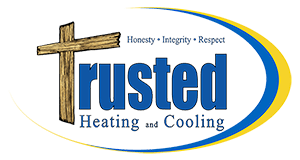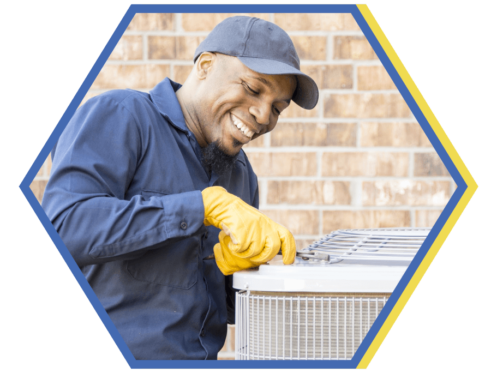How Can I Lower the Humidity in My Home?
The ideal relative humidity (RH) varies from person to person but is generally agreed to be between 30% and 50% for both comfort and health. But many homes in the U.S., particularly in the more humid climate zones, will have an RH above 60% during the hotter months. An RH in that ideal zone makes you more comfortable and less prone to illness. It makes your home less susceptible to mold and dust mites. It helps to protect wood, including the structure of your home and furniture, and when achieved via a dehumidifier, it makes your home more affordable to cool.
Use Your AC and Keep It Well Maintained
Running your AC makes your home more comfortable not only because it lowers indoor temperature but indoor humidity. While an air conditioner is not a dehumidifier, it does remove moisture from the air as a byproduct of cooling the air. Air with a lower temperature holds more water vapor and thus has a lower RH and feels more comfortable. In order to ensure peak operation, air conditioners should be serviced each spring prior to the cooling season. It is also necessary to swap out HVAC filters as needed as a dirty filter will result in reduced airflow and higher moisture content in the air.
Schedule an Energy Audit and Seal Your Home If Needed
If running your air conditioner is not enough to achieve your ideal RH, you may want to schedule an energy audit. An energy auditor will assess the building envelope in order to determine your home’s energy efficiency. If there are efficiency issues, such as inadequate insulation, insufficient weatherstripping and undesirable natural ventilation, those troubles are going to cause or exacerbate humidity problems. The auditor will also make recommendations on how to seal the building envelope, such as installing new windows and fixing cracks in your foundation.
Invest in a Whole-house Dehumidification System
The best way to have precise control of humidity in a home is through a whole-house dehumidifier. There are a variety of system configurations available, including standalone dehumidifiers and those that integrate into an existing HVAC system and use its blower. A good central dehumidifier easily allows you to reach a 30% RH even in summer and will have the added benefit of reducing how hard your AC has to work. That will make it cheaper to run on a month-to-month basis, reduce the wear and tear on the system and increase the system lifespan. You’ll also need to invest in a thermostat—preferably a smart thermostat—that can measure and report RH and control the whole-house dehumidifier.
Use Portable Dehumidifiers
You may also want to use portable dehumidifiers that you can bring into rooms that are being used. This will help to make those rooms more comfortable while allowing you, if you have a whole-house system, to set the entire home at a higher level. The same goes with ceiling fans, which you should set to spin in a counterclockwise direction during the cooling season. While ceiling fans will not directly lower RH, they will ensure that the air is distributed more evenly throughout a room.
Use Exhaust Fans in Kitchens and Bathrooms
Kitchens and bathrooms are the two main culprits when it comes to rooms that add moisture to your indoor air. This is why most residential building codes require exhaust fans in those areas. Run the fans whenever those rooms are in use, such as when cooking a meal or taking a shower, and you should continue to let them run for at least 10 minutes after you have finished to rid the space of excess moisture.
Invest in Mechanical Ventilation
The modern approach to home construction is to ensure a tight seal because it results in better energy efficiency and gives you more control over comfort. The potential downside is that any humidity and indoor air pollution issues become exacerbated because of the lack of fresh air. For this reason, many experts recommend investing in a mechanical ventilator that introduces fresh air to the home. Heat recovery ventilators (HRVs) and energy recovery ventilators (ERVs), for example, help to introduce fresh air while maintaining an optimal RH. HRVs and ERVs greatly improve indoor air quality overall and can pay for themselves by recovering heat energy from exhausted air and therefore making it cheaper to heat your home each winter.
Encapsulate Your Crawl Space
Crawl space encapsulation is certainly something that will come up during an energy audit. There is often significant humidity and air pollution in a crawlspace, and air rises from a crawl space and seeps through the floor into a home. Encapsulating a crawl space is the process of installing a moisture barrier so that the seepage cannot occur. It is also common to seal foundation vents and install a dehumidifier that keeps the crawl space at an optimal RH, which is usually about 55%, for these purposes.
Avoid Introducing Additional Moisture
You should also avoid inadvertently adding moisture to the air. For instance, avoid boiling water and other cooking techniques that create a lot of water vapor such as steaming vegetables. Limit doing laundry during the warmer months, and rather than use a dryer, consider hanging the clothes outside to air dry. Instead of taking long, hot showers, consider taking cooler showers multiple times a day.
Choose Houseplants That Absorb Moisture
Houseplants are another way that people inadvertently add moisture to their homes. The good news, however, is that there are houseplants that actually absorb moisture instead. You can use them to offset other houseplants and to lower the RH in the home naturally. Popular examples of these plants include Boston ferns, orchids, English ivy, bamboo palm, begonias and spider plants.
Clean Gutters and Downspouts
You may be amazed at just how much water your roof sheds during heavy rainfall, and clogged gutters are one of the leading causes of moisture in a home that many people don’t know about. Inspect and clean your gutters twice a year. If you do it yourself, ensure that the water is flowing freely and that the water coming out of the downspouts is being channeled a suitable distance from the foundation. You should also have your roof inspected once a year as it is also a common source of moisture in a home.
Your Home Heating and Cooling Experts in Austin
Trusted Heating & Cooling is a heating and cooling company that has decades of industry experience and is proud to serve Austin and the neighboring communities. Our company provides a wide range of indoor air quality services and would be happy to help you achieve the ideal RH in your home. We can discuss a wide variety of indoor air quality solutions including different HEPA filters and UV lights. We also install, maintain and repair all manner of heating and cooling technologies used throughout this region, including gas and electric furnaces, heat pumps, steam and hot water boilers and mini-splits. Call us today or contact us online to learn more about our services or to schedule an appointment.

